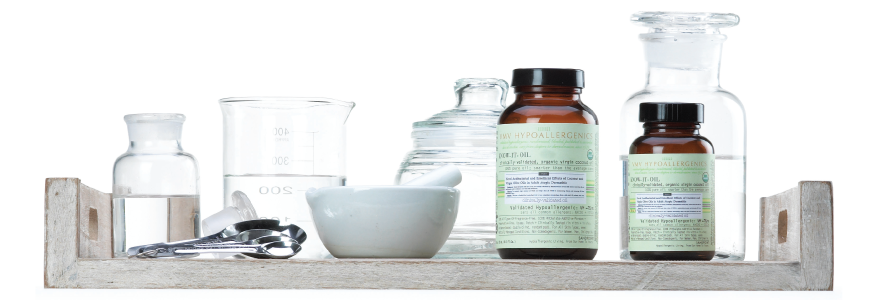Keep a bottle of virgin coconut oil on both kitchen and bathroom counters.
This healthy, anti-inflammatory fat has less calories than other edible oils and many, many more benefits for skin, mind and body
MY BEAUTY-FULL KITCHEN
Skin health begins in the kitchen. You already know junk food is appropriately named but do you know why exactly fatsand antioxidants are so important, which fats you should be eating, and why getting antioxidant supplements might beuseless? We plied our founding dermatologist-dermatopathologist — one of the leading experts on virgin coconut oiland the relationship between skin and inflammation — for information and got a pantry full of answers!
Your cell wall is a sophisticated “machine” that communicates all the signals between cells, organs, nerves, tissues — it’s how your entire system functions. Cell walls — as well as other vital parts of the cells, hormones and tissues — are made up of lipids, a.k.a. fats. Lipids are the basic units that become the lipid bi-layer of each and every cell wall of the body, including the skin’s. They’re highly vulnerable to oxidation and environmental damage. To keep them healthy, think: balance and anti-inflammatory.
What’s Your SAT Score?
SATURATED FAT, THAT IS!
Fats are vital for the body, skin and brain. You need the right balance of fatty acids that make up the lipid bi-layer of your cells (your most basic building blocks). You want just the right amount of pro-inflammatory and oxidizing fatty acids — yup, you need some of these, too, to fight infection, for example, and for the necessary oxidation that your body uses for quick energy. Then you need lots of anti-inflammatory fatty acids that are more stable and that do not oxidize readily — unhealthy inflammation and oxidation are linked to several skin problems plus obesity, depression, heart diseases and cancer.
At the cell wall, saturated fatty acids stay firm and polyunsaturated fatty acids (PUFAs) stay fluid. When in balance (a 1:2 ratio), they create the ideal firmness for the cell walls to work at their optimal level. So you do need some PUFAs for firmness but too much is bad because PUFAs oxidize easily and tend to have trans fats. And you certainly need saturated fatty acids that, as it turns out, are super good for you because they’re far more stable, much less oxidizable and anti-inflammatory.
Fiendish Fats
NIX THE 6 & THE “IC”
Avoid linoleIC (think “ick” and omega-6 (think “sick”) fats like soybean, cottonseed, corn oil and shortening. They are pro-inflammatory.
What complicates the 1:2 balancing act described above is that pro-inflammatory, omega-6 PUFAs are so ubiquitous (they’re present in most processed foods). They’re so common that the ratio of pro-inflammatory omega-6 to anti-inflammatory omega-3 in people in developed markets is as skewed as 1:17 — remember, the ideal is 1:2; higher than 1:4 is considered problematic. The ratio is worse in people who eat junk food, donuts, baked goods, chips and other pre-packaged snacks regularly (once a week or more).
HYDROGENATED ANYTHING
Hydrogenation produces trans fats, another reason why unsaturated fats are a problem. PUFAs need hydrogenation to prevent rotting (some saturated oils like virgin coconut oil are self preserving and don’t need hydrogenation to keep).
“Zero trans fats” isn’t a green light either; many FDA bodies allow this claim when a product contains less than 0.5 grams of trans fats. But eating even a little over 2 grams of trans fats is already considered a real problem — that’s just about 4 servings of 0.5 grams and we usually eat far, far more than that every day.
LONG CHAIN, SHORTER LIFE
Avoid long-chain oils (soybean, corn and many vegetable oils) as they impede necessary, quick-energy oxidation (remember, this is different from damaging oxidation). Canola is a double whammy: it’s modified from a very long carbon-chain oil (rapeseed) and has trans fats.
SKIN REPERCUSSIONS
Pro-inflammatory (junk or fast food and drinks) are linked to many skin problems like acne, eczema, psoriasis, rosacea and aging.
Sallowness in the skin can be due to by-products from the breaking down of lipids. For example, lipofuscin is a yellowbrown granular pigment that is believed to be a by-product of the oxidation of PUFAs (they oxidize very easily, releasing these by-products readily).
A poor diet causes skin problems and affects vibrancy. Oxidizers and pro-inflammatories weaken cellular health — cells become sluggish and don’t shed off and replenish as well as they should. The skin ceases to function properly and appears dull.
Friendly Fats
CHEW THIS FAT: LINOLENIC ACID & OMEGA-3
Up your intake of linoleNIC (think “NICe”) acids and omega-3s in seafood, vegetables and nuts which form antiinflammatory eicosanoids.
MEDIUM CHAIN, LONGER LIFE
Virgin coconut oil’s medium-chain fatty acids make it rapidly absorbed for quick energy. It has fewer calories per cup than any other edible oil and because it’s tasty, you need less of it in recipes, so it’s less likely to contribute to obesity.
Applied on the skin, VCO has a whole range of benefits, from moisturizing even atopic skin to anti-aging functions.
Make Antioxidants the Top of Your Food Pyramid
EAT YOUR ANTIOXIDANTS, DON’T POP ‘EM IN A PILL
There are still no studies showing the positive effects of antioxidant supplements. Precisely because of their action, antioxidants tend to react to heat, light, humidity, and cooking, and break down in processing. Eat them in as natural a state as possible, close to the source, such as in the freshest fruits and vegetables, un- or less-processed grains, etc. Unlike with supplements, there are several evidence-based studies on the health benefits of such “raw” antioxidants in one’s diet.
Make It Simple: What Do I Eat?
3 TIPS:
1) Choose non-hydrogenated, saturated, medium-chain oils like virgin coconut oil (because omega-6-rich PUFAs are so common, you’re probably getting more of them than you need even if you’re avoiding them);
2) Eat more seafood, nuts and vegetables to increase your linolenic and omega-3 oils;
3) Up your antioxidants, but not from supplements — eat more fresh fruits and vegetables.
An M.D. Article Contribution. At Skintelligencenter.com, we include articles contributed by doctors who wish to provide helpful information to their patients and the public at large, or who respond to our requests to use them as professional resources. Doctors may or may not prefer to remain anonymous and we respect this preference.
These resource articles do not in any way imply an endorsement by the physician of Skintelligencenter or VMV HYPOALLERGENICS® —they are intended for informational purposes only. While written by or with resource professionals, these articles should not be relied on for diagnostic accuracy or applicability to your particular skin, which requires an in-person ocular consultation with a qualified physician. For the care of your skin, nutrition and other health needs, please consult your dermatologist, nutritionist and other appropriate physicians.





